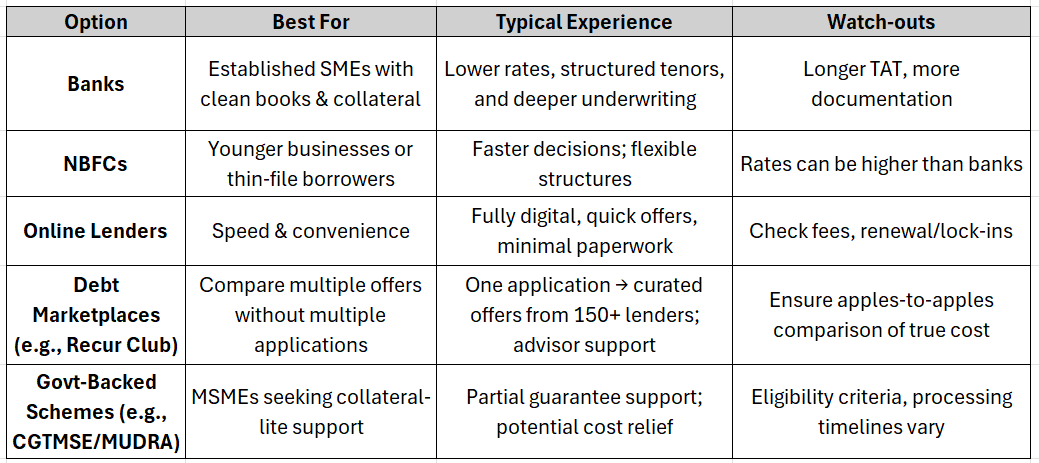Small Business Debt Consolidation Loan: Benefits and Best Options in 2025

When cash flows are tight, juggling multiple EMIs, rates, and due dates drains focus and margins. A debt consolidation loan can simplify repayments into a single schedule, often with a lower all-in cost, so you can get back to running the business.
This decision-stage guide helps Founders, CFOs, and Finance Heads evaluate if consolidation makes sense now, compare 2025 options, and pick the structure that protects cash flow and long-term cost.
Key Takeaways:
- What it is: Roll multiple business loans/limits into one facility with a single EMI.
- Why it helps: Lower interest burden, smoother monthly outflows, fewer missed-payment risks.
- 2025 choices: Banks, NBFCs, online lenders, debt marketplaces (multi-lender), and government-backed schemes.
- Decide smartly: Model true cost (not just a lower EMI), check fees/lock-ins, match tenor to cash-cycle.
What Is a Small Business Debt Consolidation Loan?
A debt consolidation loan rolls multiple loans into a single monthly payment, replacing scattered EMIs, rates, and due dates.
Done right, it can:
- Cut the effective rate you're paying
- Stabilize monthly outflows by spreading tenor
- Improve credit health with on-time, single-lender repayments
Key Benefits of Debt Consolidation for Small Businesses
- Simplifies Repayments: Merge working capital loans, CCODs, and vendor dues into one loan with a single monthly payment.
- Reduces Interest Load: Replace high-interest debts like business credit cards or short-term loans with a lower-rate consolidated loan.
- Stabilizes Cash Flow: Spread your repayments over a longer term to ease monthly pressure and free up cash for operations.
- Improves Credit Health: Timely repayment on a consolidated loan can strengthen your credit profile and future loan eligibility.
- Gives Financial Clarity: Dealing with one lender and one repayment schedule helps you plan ahead and avoid missed EMIs.
Best Debt Consolidation Loan Options for Small Businesses in 2025

Tip: If a portion of your stack is asset-backed (LAP/equipment), you might refinance that segment separately at a lower rate and consolidate only the unsecured/expensive parts.
How to Choose the Right Consolidation Loan?
- Map Every Loan: List all existing business debts: CCODs, term loans, credit cards, vendor financing, and EMIs with amounts, tenures, and rates.
- Compare Total Cost: Don’t just look at lower EMIs—calculate total interest payable post-consolidation to ensure real savings.
- Check for Extra Charges: Review the fine print for foreclosure penalties, processing fees, or restructuring costs.
- Evaluate Monthly Cash Flow: Make sure your new EMI aligns with your working capital needs and business cycles.
- Use Capital Advisory: Recur Club helps you analyse lender offers and structure the loan that fits your business, not just any loan that gets approved.
Process & Timeline (Indicative)
- Assessment & documentation (2–4 days): Submit bank statements, GST filings, financials, KYC, and loan closure letters for review.
- Offer comparison (2–5 days): Evaluate interest rates, tenors, fees, and covenants to select the best fit.
- Sanction & closures (3–7 days): Consolidate and close old accounts, update credit bureaus, and finalise terms.
- Go‑live (Day 7–14): Single EMI in place; monitor and manage via lender or marketplace dashboard.
Documents to keep handy: Last 12 months' bank statements, latest GST filings, audited financials, loan statements and foreclosure letters, collateral documents (if any), and board or partner approvals.
How Recur Club Helps?
If you want a faster, clearer path to consolidation:
- Single application → 150+ lenders (banks, NBFCs, specialty lenders)
- Curated offers in 48–72 hours (profile-dependent)
- 15+ credit structures (term loan, CCOD, RBF, invoice discounting, LAP, structured debt)
- ₹2,500 Cr+ already arranged across startups & SMEs
- Dedicated capital advisor to model true cost, negotiate terms, and manage closures
Outcome: Consolidation that improves both monthly liquidity and lifetime cost—not just a prettier EMI.
Conclusion
Consolidating your business debt can streamline your financial management and potentially free capital for reinvestment. But the real game-changer comes when you take advantage of a strategic partner like Recur Club.
Looking to simplify your finances and consolidate debt on your terms?
FAQs
1. Which lender type is best for quick approval?
Online lending platforms and NBFCs typically offer the fastest approval and disbursal. For instance, when you apply through Recur Club, funds can be credited to your bank account within 72 hours.
2. Who should consider a debt consolidation loan?
Businesses juggling multiple loans, struggling with high-interest rates, or facing cash flow issues.
3. How do I qualify for a consolidation loan?
Lenders typically look at your credit score, business financials, repayment history, and sometimes collateral.
4. Are there risks to consolidating business debt?
Possible risks include longer repayment terms (which may increase total interest paid), fees for early closure of old loans, or higher rates if your credit is weak.
5. Can I consolidate both secured and unsecured loans?
Yes, most lenders allow consolidation of different types of business loans, but terms may vary.





